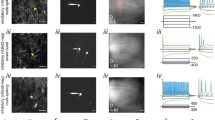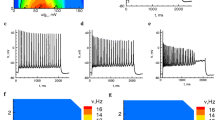Abstract
This modeling study examines the possible functional roles of two hyperpolarization-activated conductances in lateral superior olive (LSO) principal neurons. Inputs of these LSO neurons are transformed into an output, which provides a firing-rate code for a certain interaural sound intensity difference (IID) range. Recent experimental studies have found pharmacological evidence for the presence of both the G KIR conductance as well as the inwardly rectifying outward G KIR conductance in the LSO. We addressed the question of how these conductances influence the dynamic range (IID versus firing rate). We used computer simulations of both a point-neuron model and a two-compartmental model to investigate this issue, and to determine the role of these conductances in setting the dynamic range of these neurons. The width of the dynamic regime, the frequency-current (f-I) function, first-spike latency, subthreshold oscillations and the interplay between the two hyperpolarization activated conductances are discussed in detail. The in vivo non-monotonic IID-firing rate function in a subpopulation of LSO neurons is in good correspondence with our simulation predictions. Two compartmental model simulation results suggest segregation of G h and G KIR conductances on different compartments, as this spatial configuration could explain certain experimental results.
Similar content being viewed by others
References
Adam T, Finlayson P, Schwarz D (2001) Membrane properties of principal neurons of lateral superior olive. J Neurophysiol 86(2): 922–934.
Adam T, Schwarz D, Finlayson P (1999) Firing properties of choppers and delay neurons in the lateral superior olive of the rat. Exp. Brain Res. 124(4): 489–502.
Bal R, Oertel D (2000) Hyperpolarization-activated, mixed-cation current I h in octopus cells of the mammalian cochlear nucleus. J. Neurophysiol 84(2): 806–817.
Banks M, Sachs M (1991) Regularity analysis in a compartmental model of chopper units in the anteroventral cochlear nucleus. J. Neurophysiol 65(3): 606–629.
Bickmeyer U, Heine M, Manzke T, Richter D (2002) Differential modulation of I(h) by 5-HT receptors in mouse CA1 hippocampal neurons. Eur. J. Neuroscience 16(2): 209–218.
Borisyuk A, Semple M, Rinzel J. (2002) Adaptation and inhibition underlie responses to time-varying interaural phase cues in a model of inferior colliculus neurons. J. Neurophysiol 88(4): 2134–2146.
Chance F, Abbott L, Reyes A (2002) Gain modulation from background synaptic input. Neuron 35(4): 773–782.
Connor J, Walter D, McKown R (1977) Neural repetitive firing: modifications of the Hodgkin-Huxley axon suggested by experimental results of crustacean axons. Biophys. J. 18(1): 81–102.
Desjardins A, Li Y, Reinker S, Miura R, Neuman R (2003) The influences of Ih on temporal summation in hippocampal CA1 pyramidal neurons: A modeling study. J. Comput. Neurosci 15(2): 131–142.
Doiron B, Laing C, Longtin A, Maler L (2002) Ghostbursting: a novel neuronal burst mechanism. J. Comput. Neuroscience 12(1): 5–25.
Hooper S, Buchman E, Hobbs K (2002) A computational role for slow conductances: Single-neuron models that measure duration. Nat Neurosci 5(6): 552–556.
Hutcheon B, Yarom Y (2000) Resonance, oscillation and the intrinsic frequency preferences of neurons. TINS. 23(5): 216–222.
Izhikevich E (2000) Neural excitability, spiking and bursting. Int J. Bifurcation and Chaos 10: 1171–1266.
Izhikevich E (2001) Resonate-and-fire neurons. Neural Networks 14: 883–894.
Joris P (1996) Envelope coding in the lateral superior olive. II. Characteristic delays and comparison with responses in the medial superior olive. J. Neurophysiology 76(4): 2137–2156.
Joris P, Yin T (1995) Envelope coding in the lateral superior olive. I. Sensitivity to interaural time differences. J. Neurophysiology 73(3): 1043–1062.
Koch U, Groethe B (2003) Hyperpolarization-activated current (Ih) in the inferior colliculus: Distribution and contribution to temporal processing. J. Neurophysiol 90(6): 3679–3687.
Ma Y, Cui J, Hu H, Pan Z (2003) Mammalian retinal bipolar cells express inwardly rectifying K+ currents (IKir) with a different distribution than that of Ih. J. Neurophysiol 90(5): 3479–3489.
Margulis M, Tang C (1998) Temporal integration can readily switch between sublinear and supralinear summation. J. Neurophysiol 79(5): 2809–2813.
McCormick D, Huguenard J. (1992) A model of the electrophysiological properties of thalamocortical relay neurons. J. Neurophysiol 68(4): 1384–1400.
Migliore M, Messineo L, Ferrante M (2004) Dendritic Ih selectively blocks temporal summation of unsynchronized distal inputs in CA1 pyramidal neurons. J. Comp. Neurosci 16(1): 5–13.
Nicolaus J, Ulinski P (1994) Functional interactions between inwardly rectifying conductances and GABA-mediated inhibition. CNS abstract.
Park T, Klug A, Holinstat M, B. G (2004) Interaural level difference processing in the lateral superior olive and the inferior colliculus. J. Neurophysiol 92(1): 289–301.
Pinsky P, Rinzel J. (1994) Intrinsic and network rhythmogenesis in a reduced Traub model for CA3 neurons. J. Comput. Neurosci. 1(1–2): 39–60.
Redman S, McLachlan E, Hirst G (1987) Nonuniform passive membrane properies of rat lumbar sympathetic ganglion cells. J. Neurophysiol 57(3): 633–644.
Reed M, Blum J. (1990) A model for the computation and encoding of azimuthal information by the lateral superior olive. J. Acoust. Soc. Am. 88(3): 1442–1453.
Reyes A (2001) Influence of dendritic conductances on the input-output properties of neurons. Ann. Rev. Neurosci. 24: 653–675.
Rinzel J, Ermentrout G (1989) Analysis of neural excitability and oscillations in Methods in Neuronal Modeling: From Synapses to Networks. MIT Press, Cambridge MA.
Rush M, Rinzel J. (1995) The potassium A-current, low firing rates and rebound excitation in Hodgkin-Huxley models. Bull Math Biol. 57(6): 899–929.
Sanes D (1990) An in vitro analysis of sound localization mechanisms in the gerbil lateral superior olive. J. Neuroscience 10(11): 3494–3506.
Sanes D (2002) Right place at the right time. Nat Neuroscience 5(3): 187–188.
Shapiro B, Lenherr F (1972) Hodgkin-Huxley axon. Increased modulation and linearity of response to constant current stimulus. Biophys J. 12: 1145–1175.
St-Hilaire M, Longtin A (2004) Comparison of coding capabilities of Type I and Type II neurons. J. Comput. Neurosci. 16(3): 299–313.
Takigawa T, Alzheimer C (1999) G protein-activated inwardly rectifying K+ (GIRK) currents in dendrites of rat neocortical pyramidal cells. J. Physiol. 517: 385–390.
Takigawa T, Alzheimer C (2003) Interplay between activation of GIRK current and deactivation of Ih modifies temporal integration of excitatory input in CA1 pyramidal cells. J. Neurophysiol 89(4): 2238–2244.
Takigawa T, Alzheimer C (2002) Phasic and tonic attenuation of EPSPs by inward rectifying K+ channels. J. Physiol. 539: 67–75.
Tiesinga P (2004) Chaos-induced modulation of reliability boosts output firing rate in downstream cortical areas. Phys. Rev. E. 69(3): 031912.
Tollin D (2003) The lateral superior olive: A functional role in sound source localization. Neuroscientist 9(2): 127–143.
Tsuchitani C (1988) The inhibition of cat lateral superior olive unit excitatory responses to binaural tone bursts. I. The transient chopper response. J. Neurophysiol. 59(1): 164–183.
Wessel R, Kristan W, Kleinfeld D (1999) Supralinear summation of synaptic inputs by an invertebrate neuron: Dendritic gain is mediated by an “inward rectifier” K(+) current. J. Neurosci 19(14): 5875–5888.
Wilson C (1995) Dynamic modification of dendritic cable properties and synaptic transmission by voltage-gated potassium channels. J. Comput Neurosci 2(2): 91–115.
Wilson C (2005) The Mechanism of Intrinsic Amplification of Hyperpolarizations and Spontaneous Bursting of Striatal Cholinergic Interneurons. Neuron 45(4): 575–585.
Zacksenhouse M, Johnson D, Williams J, Tsuchitani C (1998) Single-Neuron Modeling of LSO Unit Responses. J. Neurophysiol. 79(6): 3098–3110.
Author information
Authors and Affiliations
Corresponding author
Additional information
Action Editor: David Golomb
Rights and permissions
About this article
Cite this article
Szalisznyó, K. Role of hyperpolarization-activated conductances in the lateral superior olive: A modeling study. J Comput Neurosci 20, 137–152 (2006). https://doi.org/10.1007/s10827-005-5637-5
Received:
Revised:
Accepted:
Published:
Issue Date:
DOI: https://doi.org/10.1007/s10827-005-5637-5




